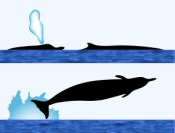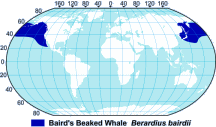Baird's Beaked Whale
CLASS: Mammalia
ORDER: Cetacea
SUBORDER: Odontoceti
FAMILY: Ziphiidae
GENUS: Berardius
SPECIES: Bairdii
Baird’s beaked whale is the largest of all the beaked whales, sometimes reaching a maximum length of 42 feet (12.8 m). This species may be the only large beaked whale found in the North Pacific. Because it tends to avoid ships, sightings of Baird’s beaked whales are infrequent. Its blow is low and indistinct, which may be another reason why they escape detection at sea. The species was named for Spencer F. Baird, a secretary of the Smithsonian Institution and well-known naturalist of the late 1800s.
Physical Description
The body of Baird’s beaked whale is round and tapering towards the head and tail. Its head is small, only about 1/8 of the total body length with a distinctive, high, bulbous forehead that slopes steeply to a long, thin beak much like a dolphin beak. This whale can be identified when it surfaces to breathe; its head comes out of the water at a steep angle allowing the bulging forehead and beak to be seen clearly. Its lower jaw extends 4 inches (10 cm) beyond the upper jaw exposing two sets of teeth near the tip of the snout. There are no teeth in its upper jaw. The forward pair of teeth is about 3 1/2 inches long (9 cm), and about 8 inches behind these teeth is a second pair of teeth only about 2 inches high (5 cm). The teeth may often be seen when they raise their heads to breathe. Baird’s beaked whale has the 2 v-shaped throat grooves that are typical of all beaked whales. surface characteristics

Surface Characteristics
Color
This whale’s color ranges from blue-gray to brown to black on the dorsal or upper side of the body, and light gray on the ventral (under) side of the body. Most Baird’s beaked whales have many white scars and scratches on their backs and sides.
Fins and Fluke
A small, triangular fin is located 2/3 of the way back on its body. Its flukes are equal to about 1/4 the body length and are slightly rounded at the tips with no notch in the center. It has small flippers that are rounded at the tips and located well forward on the body.
Length and Weight
The largest recorded male was 39 feet (11.9 m) and the largest recorded female was 42 feet (12.8 m). The average weight has been estimated at 12 tons (11,000 kg). Females are larger than males of the same age.
Feeding
Baird’s beaked whale eats squid, octopus, mackerel, sardines, and deep sea fishes.
Mating and Breeding
Males may reach sexual maturity at 32-36 feet (10-11 m) and the females at 32-34 feet (10-10.3m). Calves measure 15 feet (4.5 m) at birth and the gestation period is estimated to be from 12 to 17 months. It is thought that females have calves every 3 years. range map

Range Map
Distribution and Migration
Baird’s beaked whales are found only in the North Pacific. Their range is from Japan to southern California/Baja area northward to the Bearing Sea.
Natural History
This is a deep water species found mostly at depths of 3,300 feet (1,000 m), rarely entering shallow waters. Sometimes seen in pairs, they usually travel in larger social groups of 6 to 30 animals. Their lifespan may be up to 70 years.
Status
We have no estimates of population past or present. Some commercial whaling of Baird’s beaked whales was done by Japan, mostly in the 1950s. In 1952, a peak year, 322 were harvested by Japanese coastal whaling operations. Russia also hunted them in the past, but found it unprofitable to continue because they were so scarce.
Bibliography
- Balcomb, Kenneth; Minasian, Stanley, The World’s Whales. Illustrated by Larry Foster. A Complete Illustrated Guide. Smithsonian Books, New York; W. W. Norton, 1983
- Jefferson, T.A., M.A. Webber, R.L. Pitman. 2015. Marine Mammals of the World: A Comprehensive Guide to their Identification, 2nd edition. Elsevier/AP.
- Leatherwood, S; Reeves, R. Whales and Dolphins. San Francisco; Sierra Club Books, 1983.
Acknowledgements
- Illustrations courtesy Uko Gorter, copyright ©2017 all rights reserved.
FACT SHEETS MAY BE REPRINTED FOR EDUCATIONAL OR SCIENTIFIC
|



